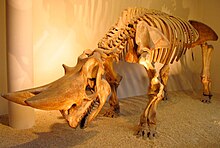Arsinoitherium
| Arsinoitherium | |
|---|---|

| |
| A. zitteli cast, Natural History Museum, London | |
| Scientific classification | |
| Domain: | Eukaryota |
| Kingdom: | Animalia |
| Phylum: | Chordata |
| Class: | Mammalia |
| Order: | †Embrithopoda |
| Family: | †Arsinoitheriidae |
| Genus: | †Arsinoitherium Beadnell 1902 |
| Type species | |
| Arsinoitherium zitteli Beadnell, 1902
| |
| Species | |
| |
Arsinoitherium is an extinct genus of
Taxonomy
The best-known (and first-described) species is A. zitteli. Another species, A. giganteum, was discovered in the Ethiopian highlands of Chilga in 2003. The fossil teeth, far larger than those of A. zitteli, date to around 28–27 million years ago.[1] While the Fayum Oasis is the only site where complete skeletons of Arsinoitherium fossils were recovered, arsinoitheriids have been found in southeastern Europe, including Crivadiatherium from Romania, and Hypsamasia and Palaeoamasia from Turkey.
The
Description

Adults of the species A. zitteli stood around 1.75 m (5.7 ft) tall at the shoulders and 3 m (9.8 ft) in length.
Distribution

Fossils of Arsinoitherium have been found in:[12]
- Eocene
- Oligocene
- Malembe, Angola
- Jebel Qatrani Formation, Egypt
- Chilga formation, Ethiopia
- Erageleit Formation, Kenya
- Ashawq Formation, Oman
- Shumaysi Formation, Saudi Arabia
References
- ^ Sanders, W.J., Kappelman, J., and Rasmussen, D.T. 2004. New large−bodied mammals from the late Oligocene site of Chilga, Ethiopia. Acta Palaeontologica Polonica 49 (3): 365–392.[1].
- ^ "Geographica". apps.lib.umich.edu. Retrieved 2024-03-17.
- ^ Beadnell, H.G.C. (1902). "A preliminary note on Arsinoitherium zitteli, Beadnell, from the Upper Eocene strata of Egypt". Public Works Ministry, National Printing Department. Cairo: 1–4.
- ^ a b Andrews, C.W. (1906). A descriptive catalogue of the Tertiary Vertebrata of the Fayûm. British Museum, London. Taylor and Francis. p. 324.
- ^ Mondéjar-Fernández; et al. (2008). "El género Arsinoitherium: catálogo de la colección inédita del Muséum d'Histoire Naturelle de París y el problema del número de especies". Palaeontologica Nova (in Spanish). SEPAZ (8): 292–304.
- ISSN 1871-174X.
- ^ Andrews, C. W. (1906). A descriptive catalogue of the Tertiary Vertebrata of the Fayum. Publ. Brit. Mus. Nat. Hist. Land. XXXVII.
- ^ Anonymous. (1903). A New Egyptian Mammal (Arsinoitherium) from the Fayûm. (1903). Geological Magazine, 10(12), 529-532.
- ISBN 978-0231119450.)
{{cite book}}: CS1 maint: multiple names: authors list (link - ^ Sanders, W. J., Kappelman, J., & Rasmussen, D. T. (2004). "New large-bodied mammals from the late Oligocene site of Chilga, Ethiopia". Acta Palaeontologica Polonica. 49 (3).
{{cite journal}}: CS1 maint: multiple names: authors list (link) - ISSN 0891-2963.
- ^ Arsinoitherium at Fossilworks.org
External links
- New fossils from Ethiopia open a window on Africa's 'missing years'
- Arsinoitherium fact file on BBC Science & Nature: Prehistoric Life
- Description of Arsinoitherium zitteli from upper Eocene strata in Egypt
- Vincent L. Morgan and Spencer G. Lucas (2002). "Notes From Diary––Fayum Trip, 1907". Bulletin 22. PDF) on 2009-07-20. Retrieved 2017-09-08.


